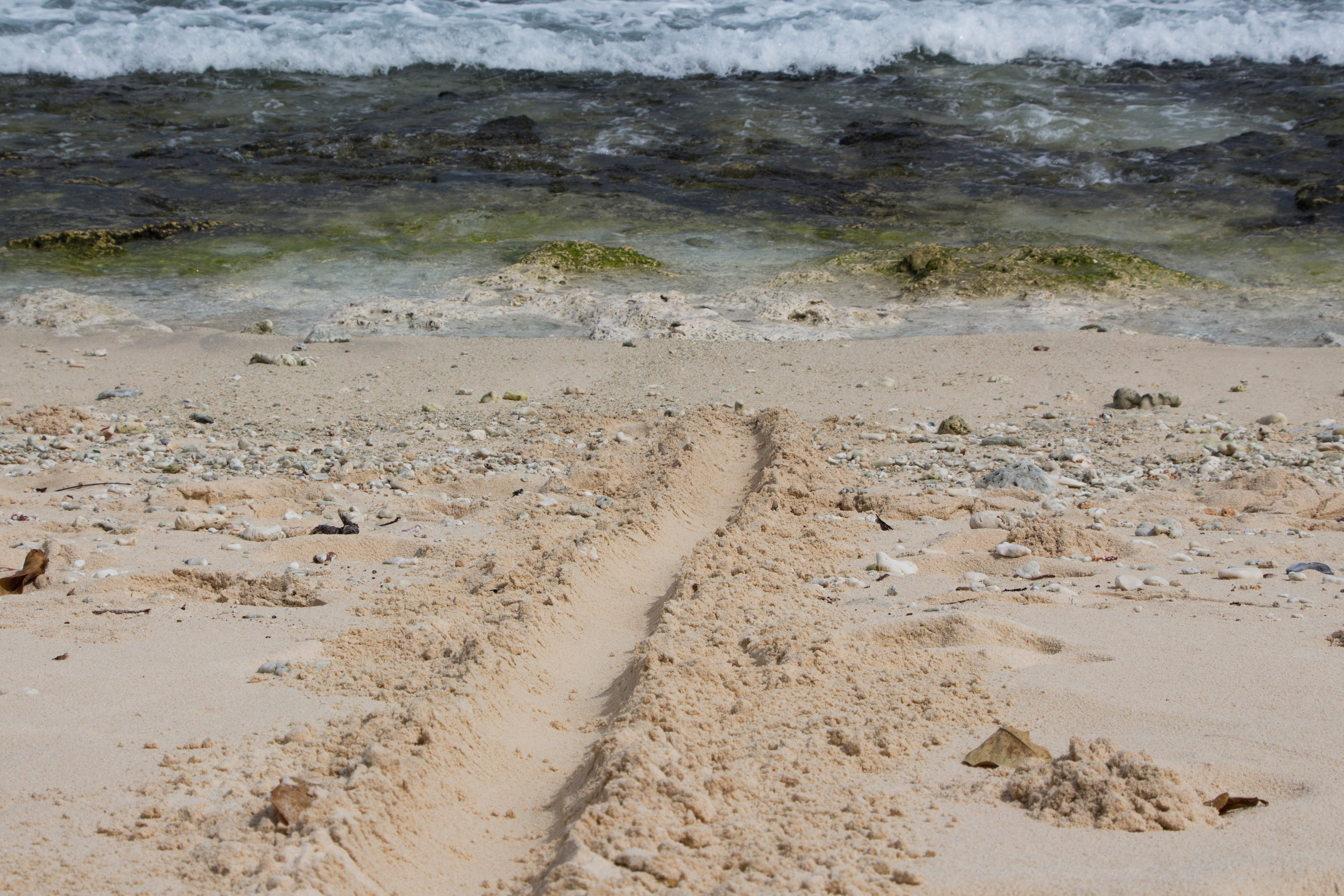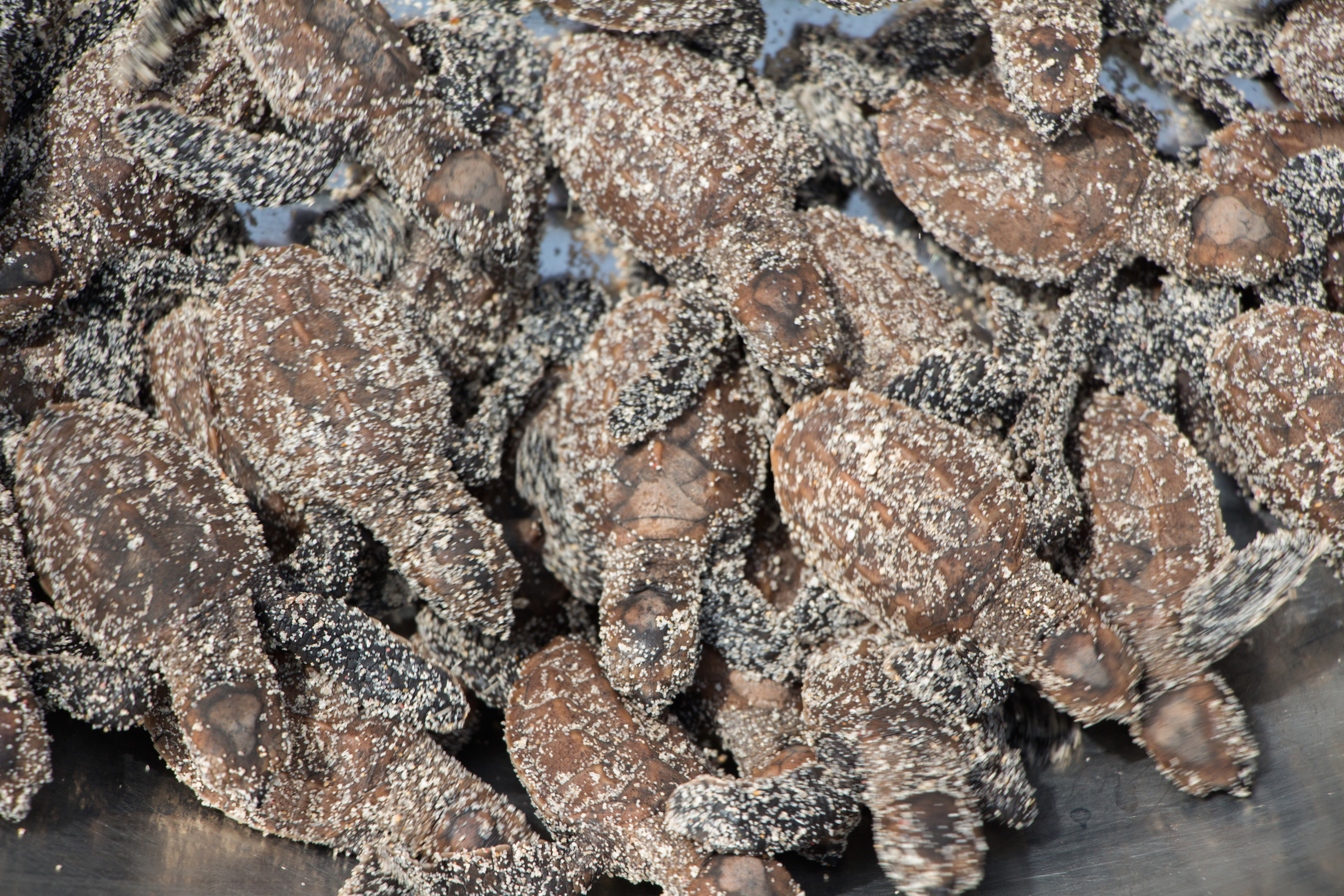She was nearly ready.
Tucked up beneath the overhanging vegetation, the female hawksbill had nearly finished digging her nest, methodically scooping sand out of the hole, flipper by flipper. We waited nearby in the darkness, silent and spellbound beneath the palms as the sky shifted from grey to black with the impending storm.
Her eggs began falling as the first drops of rain splattered against her barnacle-encrusted shell. Two, four, one, then three at once, all of them glistening in the glow of the surf. Each one of them a small victory.
After a 40-year history punctuated by arson, conflict, and poaching, conservation efforts in the Arnavon Islands are yielding a glimmer of hope for hawksbill sea turtles. Now, Conservancy scientists are working with local communities to make these critical islands the first site to be registered under the Solomon Islands’ 2010 Protected Areas Act.
From Headhunters to World War II
Archaeologists can trace the turtle trade back more than 3,000 years in the Arnavons, when the ancestors of the Roviana headhunters visited the islands to fish the reefs and harvest turtles for their shells and meat.
By the 1800s, hawksbill shell — often erroneously called tortoiseshell — became the first major export from the Solomons. Each year the shells from an estimated 1,000 turtles — mostly from the Arnavons — were stowed beneath the decks of whaling ships and transported to London, where craftsmen carved them into hair combs and snuff boxes. Roviana headhunters from New Georgia controlled the supply, trading shell for iron ore that they forged into tomahawks to further their headhunting raids in the surrounding islands.
The shell trade continued to grow, after a brief interruption by World War II, fueled first by post-war development efforts in Japan and then rising Asian economies. “For at least 150 years, 1,000 to 3,000 hawksbills were being taken out of the Solomons each year,” says Hamilton, “with many of them coming out of the Arnavons.”
Hawksbill populations across the world collapsed mid-century, and in 1975 the species was listed under CITES, followed two years later by a complete ban on all international trade. But demand from China and Japan continued, as did the harvesting.

Arson on the Arnavons
As the last three eggs tumbled into the nest, the rangers grabbed the turtle and gently pulled her to the side, watching to make sure she didn’t return to the water. The next morning we would attach a satellite tracker to her shell to learn more about the migratory patterns of Arnavons hawksbills.
They set to work, Leslie quickly emptying the nest by the handful on the soft, churned-up sand nearby. Within a minute the nest was empty, and he started to replace the eggs, two by two, counting as he went. For each 10 eggs he left one off to the side, and when the pile was over he counted the total by tens.
“One eight five” he said, smiling as he gently scraped sand over the pile, finishing the job the female turtle started. Nearby, the turtle continued to paddle sand over the nonexistent nest beneath her with her back flippers, pausing to lift her barnacle-encrusted head every few minutes.
It’s only then that I realize that this turtle is older than I am, perhaps by decades.

Conservation efforts in the Arnavons began in the early 1970s, when the Solomon Islands’ government — still under British rule — realized that the islands were a regionally important rookery for hawksbills. The government built a monitoring station and passed a trespassing law, forbidding access for anyone but government conservation officers.
But this top-down approach excluded the traditional owners of the Arnavons — the communities of Kia and Katupika — and the recently established community of Wagina. Resentment simmered until 1982, when Rence Zama loaded his canoe with 10 litres of petrol, traveled from Katupika to the Arnavons, and burnt down every single building on the islands. He served three years in jail for arson, missing the death of his father and the birth of his first son.
“You can’t exclude people from the nature equation,” says Hamilton. “In the Solomon Islands, people are dependent on natural resources for their livelihoods and on top of that have traditional ownership of those resources, so involving communities in the conservation process is paramount.”
Following the arson the government wrote the Arnavons off as a disaster and all protection and monitoring efforts ceased. Harvesting throughout the country accelerated through the decade, and Hamilton says that by the late 1980s and early 1990s an estimated 5,000 to 6,000 turtles were being killed every year in the Solomons, the vast majority coming out of the Arnavons.
You can’t exclude people from the nature equation.
Richard Hamilton
After a decade the national government turned their attention to the Arnavons once again, revamping the monitoring program and initiating discussions with the provincial governments, the Conservancy, and leaders from Wagina, Katupika, and Kia about the islands’ future. After three years of conflict and discussion, all parties came together to form the Arnavons Community Marine Conservation Area (ACMCA) in 1995 — the Solomon Island’s first community-based marine protected area. Zama, once outspoken about his resentment of conservation on the island, is now on the ACMCA board.
“It took so long to bring these people together against all odds, cultural norms, and differences,” says John Pita, the Conservancy’s environment coordinator for Isabel Province. “But it means so much.”





The Future of the Arnavons
Ten hours later we were back on the beach, just a few dozen meters away from where the female turtle laid her eggs the previous evening. But this time a nest was about to hatch.
One by one Dickson helped the struggling turtle hatchlings free of the sand. They clambered down the sandy runway we dug for them with coconut shell, pausing every few meters to rest. With each break they craned their tiny heads skyward to gulp air, instinct guiding them to poke their heads above the water’s surface before they had even felt their first wave.
These hatchlings are just a handful of tens of thousands that have hatched on the Arnavons this year — and perhaps a dozen or so of them will return 35 years from now when they reach breeding age. Each nest is carefully monitored by the conservation rangers, who label them with the date the nest was laid and protect them from predators with wire mesh. And when a female misses her mark and lays below the high-tide line, the rangers relocate the nest, egg by egg, to a safer location.
Their efforts, and those of the ACMCA founders, are paying off. Analysis of the monitoring data revealed that the number of hawksbill turtle nests laid on the Arnavons has more than doubled in the past 20 years.

But even the Arnavons’ status as a community protected area — the rangers’ dedication — hasn’t stopped poaching entirely. Just two weeks after our tagging fieldwork, two of our turtles were butchered by poachers from the nearby Wagina community.
“For the last 20 years enforcement has been our weakness,” explains Pita. National-level laws protect turtles on paper, but without local enforcement they do little to protect turtles on the ground. Part of the problem is a lack of data documenting legal and illegal harvests, so Hamilton and Pita are gearing up to begin a year-long investigation into turtle harvest rates.
The other side of the equation is capacity — bodies on the beach to both deter and apprehend poachers. And an existing law could provide this support for the Arnavons.
In 2010 the Solomon Islands passed the Protected Areas Act, designed to create a network of terrestrial and marine protected areas around the country supported by additional legal protection. In places where poaching of natural resources and wildlife is a problem, the law would give local rangers the authority to arrest poachers on the spot and confiscate their boats and gear.
By elevating the local governing authority to the national level — instead of the provincial — the Protected Areas Act would provide the legal frame for prosecution of poachers at the national level. It would also mean higher fines for poaching and potentially allow government funding to flow into the islands.
“If we can get the Arnavons in the protected area network I believe we can solve the poaching problem,” says Pita.
But there’s a catch — six years after the law was passed, the government has yet to add a single site to the so-called network. Hamilton and Pita are trying to make the Arnavons the first site.
“We are very close to getting the Arnavons listed,” says Hamilton. After receiving the final endorsements for the plan from the local governments, ACMCA coordinator Henry Kaniki will submit the final paperwork to the Ministry of the Environment in late May. Hopefully, approval from the government will follow soon.
We watched as a wave crashed over the last hatchling, sweeping it out to sea over the rocky, coral-covered shoreline. Dozens of turtles struggled along ahead, paddling furiously as the waves rolled over them. In the calm beyond the break we could see tiny pinpricks on the water’s flat surface — each hatchling coming up for one long breath.
A few of them will return more than three decades from now, hopefully to a safer Arnavons.



Hi Justine,
Thank you for the recent information on poaching from the Wagina community. I am one of the masters student who is conducting research on the capture and consumption of sea turtles for the Manning Strait. Your information is very pertinent.
Regards
Rishi